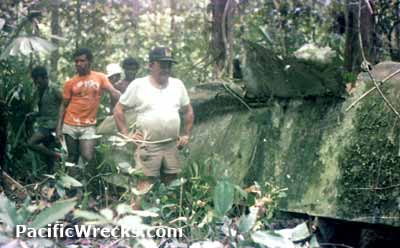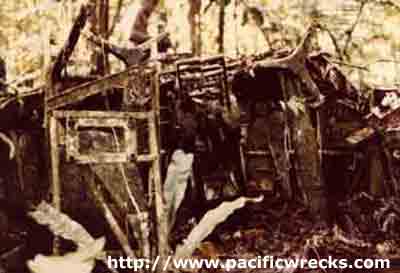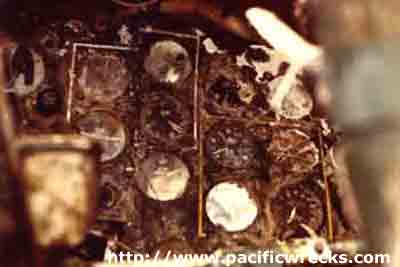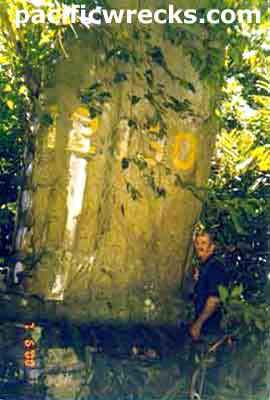Brian J. Bennett
PNG Resident, Wreck Researcher, CILHI/JPAC Consultant
In Memory: Brian Bennett passed away on December 8, 2014.
New Zealander Brian Bennett has lived in Papua New Guinea (PNG) for most of his life, acquiring an intimate knowledge of the Rabaul area in particular. Over the decades, Brian has
been responsible for locating many important wrecks in New Britain. During 1981 until the middle 2000s, he worked a consultant
for US Army CILHI / JPAC to assist in locating Missing In Action (MIA) Americans in PNG.
Tell a little about yourself
 My name is Brian Bennett and I am a New
Zealand citizen but have been a long time resident of Papua New
Guinea (PNG) for the last 32 years. I am married to Fida, a Tolai woman from
the Gazelle Peninsula of New Britain Island. We have three children,
all grown up now and resident in Australia. In 1970, a forest industries consultant in New Zealand originally
recruited me to work as forest surveyor at Vanimo on the
PNG and Indonesian border. After a year at Vanimo I left to go exploring
I suppose and went to Lae where I took up a position with a private
survey firm engaged to do rural road survey for the then Australian
Administration in PNG. My name is Brian Bennett and I am a New
Zealand citizen but have been a long time resident of Papua New
Guinea (PNG) for the last 32 years. I am married to Fida, a Tolai woman from
the Gazelle Peninsula of New Britain Island. We have three children,
all grown up now and resident in Australia. In 1970, a forest industries consultant in New Zealand originally
recruited me to work as forest surveyor at Vanimo on the
PNG and Indonesian border. After a year at Vanimo I left to go exploring
I suppose and went to Lae where I took up a position with a private
survey firm engaged to do rural road survey for the then Australian
Administration in PNG.
How did you
get interested in WWII History?
I guess I was always interested in war
history as a kid, as my father fought in the Solomon Is with the
3rd New Zealand Division and was decorated for gallantry twice. From an early
age I had my uncles and their friends around me, all veterans.
What were your early days in New Guinea
like?
When I first arrived in PNG I did not see much in
the way of war relics in the Vanimo district. While there, I did
get to go down to a place called Aitape and this was before most
of the aircraft left there were collected and carted off to the
states. I recall this vast or so it seemed area of aircraft left
behind and but my friend and I had a great time sitting in all of
them. At that age the opening of the new Aitape Hotel did go back
to first priority.
After I arrived in Lae you noted that there were
relics all over the place and readers might know of the book published
many years ago called "Pacific Battlefields", well many
of the items photographed in that were around for the seeing when
I was there. I still recall the great pile of Japanese Naval “Long
Lance” torpedoes stacked up in the yard of a sawmill in Lae.
I wonder what happened to all the propulsion units. You could go
out to Nadzab in those days and there was stuff lying everywhere
and it was really only a matter of following your nose and you could
always pick up something interesting.
Later on I got to work for a while in the Ramu
Valley so Gusap, Dumpu and up around Shaggy Ridge all got tramped
on Bulolo and Wau area where war relics were still just ho hum
stuff but good places to build up the interest. I finally ended up in the East New Britain Province
at Rabaul and was where I would spend a good part of working life
and where I raised a family, it was also an area as I was to quickly
find out one of the richest places in the SW Pacific for WWII History
and even better for me, terrain littered with aircraft. Because
of the nature of my work in the forestry sector I have been able
to travel extensively in PNG and of course use nearly any excuse
to take an opportunity to go hunting balus, the metal not the feathered
variety.
What was the first aircraft
wreck you visited?
 My first aircraft crash site was in 1971
while I was on loan to a government patrol in the Leron Valley.
I was to accompany the patrol and report on the feasibility of a
road from the Leron Bridge to an inland patrol post called Wantoat.
Up in the hills behind a little hamlet called Sira-Sira the Patrol
Officer (Kiap) and myself went to investigate the source of a piece of
wreckage we had seen in the hamlet. This turned out to be a crashed
Japanese bomber complete with the remains of the crew. Other that
the fact that it was Japanese from an obvious “Rising Sun”
on a wing neither of us had a clue what the aircraft type was but
we picked up bones which were delivered at a later date to the district
Office in Lae. My first aircraft crash site was in 1971
while I was on loan to a government patrol in the Leron Valley.
I was to accompany the patrol and report on the feasibility of a
road from the Leron Bridge to an inland patrol post called Wantoat.
Up in the hills behind a little hamlet called Sira-Sira the Patrol
Officer (Kiap) and myself went to investigate the source of a piece of
wreckage we had seen in the hamlet. This turned out to be a crashed
Japanese bomber complete with the remains of the crew. Other that
the fact that it was Japanese from an obvious “Rising Sun”
on a wing neither of us had a clue what the aircraft type was but
we picked up bones which were delivered at a later date to the district
Office in Lae.
I remember being quite surprised at the time over
the crash site and of course the unrecovered crew as I had this
idea that after a war was over people went out and cleaned up the
mess, it was from this little adventure that I “got into it”
as they say. That year, Xmas 1971, I received
as a present from my then fiancée later my wife, a copy of
Francillon’s wonderful book Japanese
Aircraft of the Pacific War and I have been hooked on all things
aviation in New Guinea ever since.
Tell about working with
CILHI to locate and recover American MIAs
 My association with the U.S. Army Central
Identification Laboratory [JPAC] out of Hawaii started way back in 1981,
when I wrote to Colonel Rosenberg who was then commander of a unit
very much smaller that what it is today. I had an inquiry regarding
a F4U that I had found. In 1983 a crash site was reported to me by the
logging manager of a company who were operating in an area south
of the Warangoi River. After visiting the site which turned out
to be B-25C "Skilla" 42-64570 with human remains on site I reported
this fact to CILHI and some time later became involved with my first
recovery exercise with the unit. I recall that it was only a small
team led by then Major Johnie Webb, now Deputy Commander of CILHI. My association with the U.S. Army Central
Identification Laboratory [JPAC] out of Hawaii started way back in 1981,
when I wrote to Colonel Rosenberg who was then commander of a unit
very much smaller that what it is today. I had an inquiry regarding
a F4U that I had found. In 1983 a crash site was reported to me by the
logging manager of a company who were operating in an area south
of the Warangoi River. After visiting the site which turned out
to be B-25C "Skilla" 42-64570 with human remains on site I reported
this fact to CILHI and some time later became involved with my first
recovery exercise with the unit. I recall that it was only a small
team led by then Major Johnie Webb, now Deputy Commander of CILHI.
Talk about B-17E "Naughty But Nice" 41-2430
 B-17E "Naughty But Nice" 41-2430 was relocated by myself in the company of Jose Holguin the navigator
of the crew and only member to survive, and Bruce Hoy who was then
Curator of the Modern History Branch of the National Museum. After some correspondence with Holguin I was able
to get a fair idea of where the crash site might be and eventually
one day the three of us took a helicopter out to the nearest village
to make enquirers. As is often the case the “locals”
often know what you are looking for and I had warned the others
that we would either “ come up trumps” or get a vague
answer or a plain blank look. B-17E "Naughty But Nice" 41-2430 was relocated by myself in the company of Jose Holguin the navigator
of the crew and only member to survive, and Bruce Hoy who was then
Curator of the Modern History Branch of the National Museum. After some correspondence with Holguin I was able
to get a fair idea of where the crash site might be and eventually
one day the three of us took a helicopter out to the nearest village
to make enquirers. As is often the case the “locals”
often know what you are looking for and I had warned the others
that we would either “ come up trumps” or get a vague
answer or a plain blank look.
 We got a sort of vague answer which was “the balus (aircraft) up the hill or the one down the valley. Decisions
to make. Joe was getting on a bit and as we had possibly the oldest man in the village as
a guide we chose to go down the valley. Eventually we arrived at the bank of a pleasant
stream in a pristine jungle setting {I have always wanted to write
that} at which point our guide said that he recalled some wreckage
somewhere up on a low ridge somewhere on the far side. At this stage
the weather started to turn bad so time was now of the essence if
we were to achieve anything. We got a sort of vague answer which was “the balus (aircraft) up the hill or the one down the valley. Decisions
to make. Joe was getting on a bit and as we had possibly the oldest man in the village as
a guide we chose to go down the valley. Eventually we arrived at the bank of a pleasant
stream in a pristine jungle setting {I have always wanted to write
that} at which point our guide said that he recalled some wreckage
somewhere up on a low ridge somewhere on the far side. At this stage
the weather started to turn bad so time was now of the essence if
we were to achieve anything.
 As I was the one that spoke Pidgin English and
could therefore convey what we were to do I headed off into the
jungle with a group of keen locals to see what we could find, if
in fact we were in the right place. The first piece of wreckage
to turn up was an engine supercharger lying on its own at the base
of a low ridge, I then spread the boys out into a skirmish line
and off we went. As I was the one that spoke Pidgin English and
could therefore convey what we were to do I headed off into the
jungle with a group of keen locals to see what we could find, if
in fact we were in the right place. The first piece of wreckage
to turn up was an engine supercharger lying on its own at the base
of a low ridge, I then spread the boys out into a skirmish line
and off we went.
Then I found the aircraft and to this day it is
so fresh on the memory. I walked up over the edge of the ridge,
machete in hand, and all but fell into the back of the cockpit.
Immediately apparent were the control columns then the seat backs
and after leaning forward and clearing some ferns away you could
see a quite well preserved instrument panel. Well, you always get
a bit excited over things like this so I shouted out for the others
to come up and a little bit later Bruce located the still intact
nose art ”NAUGHTY but NICE” which aided in correlating
the aircraft.
 It was a sad time for Joe Holguin as this was the
place where a long difficult part of his life started. I left early
to go back for the helicopter as the weather had really deteriorated
and left the others to explore some more. Some time later Joe recovered the cockpit nose
section to Rabaul where it languished for some time then in 1989
when I and several others put the present Kokopo Museum together
I dismantled the cockpit as much was corroded and placed the cockpit
in the museum together with the nose art that was restored but that
is another story. We walked into the site, carried everything on
our backs and lived on MREs for the several weeks we were there.
Over the years I have researched and relocated other B-17's on the
Gazelle as well as innumerable Japanese crash sites. It was a sad time for Joe Holguin as this was the
place where a long difficult part of his life started. I left early
to go back for the helicopter as the weather had really deteriorated
and left the others to explore some more. Some time later Joe recovered the cockpit nose
section to Rabaul where it languished for some time then in 1989
when I and several others put the present Kokopo Museum together
I dismantled the cockpit as much was corroded and placed the cockpit
in the museum together with the nose art that was restored but that
is another story. We walked into the site, carried everything on
our backs and lived on MREs for the several weeks we were there.
Over the years I have researched and relocated other B-17's on the
Gazelle as well as innumerable Japanese crash sites.
Mention your discovery of Beaufighter A19-139
I have been most fortunate in that my interest
in researching and hunting down missing aircraft has led me not
only to many U.S. cases but occasionally to the odd Australian one.
In 1995 in company with two other “expats” I finally
got into a long overdue mystery site and identified a missing Beaufighter
up on the Kuru River behind Kimbe in West New Britain. This was
Coates and Chapple who were recovered a short time later and laid
to rest at the Beautiful War cemetery at Batapaka near Rabaul.
Tell about your work today
with CILHI/JPAC in PNG
From 1983 on to the present I have had a long association with CILHI
and have had the opportunity to be involved in a number of recoveries
in different parts of PNG. I have worked
on some very difficult sites that were also very rewarding, with
the results that were achieved. But these are all other stories
and probably worth a book each so perhaps another day.
In November 2000 I was approached by CILHI and
offered a position as a resident field historian based in Papua
New Guinea. Instead of being in Rabaul I am now based in the Capitol
Port Moresby where I am essentially a liaison officer for CILHI
to PNG [2001 - 2005]. I aid in many of their activities while also acting as a
conduit for reports of crash sites from both nationals out in the
bush and the several other “ expats” who actively hunt
MIA aircraft.
I essentially work from home and spend a lot of
time re-working old records as I have an extensive knowledge of
PNG and things that were/are mystery many years ago for the earlier
search efforts are perhaps not so much now. Currently CILHI is enjoying
considerable success with recoveries in PNG with a number of new
crash sites coming to light in this last year.
It may come as a surprise to many who access the
Pacific Wrecks site that CILHI has someone permanently working for
them in PNG but I have been reluctant to advertise the fact as by
the nature of what I am involved with which is “Missing Personnel”
then I am often not able to mention details on aircraft recently
found or those on the current active list for recovery.
CILHI’s policy is to discuss specifics of
an individual once they have been identified and the service member’s
family has been fully briefed. Rather than
be in print, so to speak, I prefer to just toil away at the coalface
which out here in PNG is “out in the scrub” looking
for the sites.
Memorial
Brian Bennett passed away on December 8, 2014. According to his wishes, his ashes were buried at Bitavavar village, East New Britain Province, Papua New Guinea, his wife Fida's village.
Published articles by Brian Bennett
FlyPast "Last of the Ship Bsters" by Brian Bennett pages 18-19
Thank you, Mr. Bennett for the interview
|






